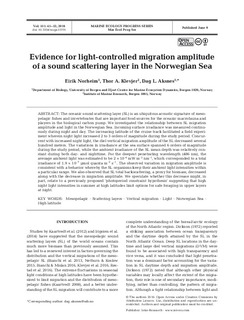| dc.contributor.author | Norheim, Eirik | |
| dc.contributor.author | Klevjer, Thor A. | |
| dc.contributor.author | Aksnes, Dag Lorents | |
| dc.date.accessioned | 2016-08-24T12:06:11Z | |
| dc.date.accessioned | 2016-09-21T13:00:53Z | |
| dc.date.available | 2016-08-24T12:06:11Z | |
| dc.date.available | 2016-09-21T13:00:53Z | |
| dc.date.issued | 2016-06-09 | |
| dc.identifier.citation | Norheim E, Klevjer TA, Aksnes DL (2016) Evidence for light-controlled migration amplitude of a sound scattering layer in the Norwegian Sea. Mar Ecol Prog Ser 551:45-52 | nb_NO |
| dc.identifier.issn | 0171-8630 | |
| dc.identifier.uri | http://hdl.handle.net/11250/2409381 | |
| dc.description | - | nb_NO |
| dc.description.abstract | The oceanic sound scattering layer (SL) is an ubiquitous acoustic signature of mesopelagic fishes and invertebrates that are important food sources for the oceanic macrofauna and players in the biological carbon pump. We investigated the relationship between SL migration amplitude and light in the Norwegian Sea. Incoming surface irradiance was measured continuously during night and day. The increasing latitude of the cruise track facilitated a field experiment wherein night light increased 2 to 3 orders of magnitude during the study period. Concurrent with increased night light, the diel vertical migration amplitude of the SL decreased several hundred meters. The variations in irradiance at the sea surface spanned 6 orders of magnitude during the study period, while the ambient irradiance of the SL mean depth was relatively constant during both day- and nighttime. For the deepest penetrating wavelength (486 nm), the average ambient light was estimated to be 2 × 10-6 mW m-2 nm-1, which corresponded to a total irradiance of 1.9 × 10-7 µmol quanta m-2 s-1. The observed variation in migration amplitude is consistent with a behavior whereby the SL organisms keep their ambient light intensities within a particular range. We also observed that SL total backscattering, a proxy for biomass, decreased along with the decrease in migration amplitude. We speculate whether this decrease might, in part, relate to a previously proposed ‘photoperiod constraint hypothesis’ suggesting that high night light intensities in summer at high latitudes limit options for safe foraging in upper layers at night. | nb_NO |
| dc.language.iso | eng | nb_NO |
| dc.publisher | Inter-Research | nb_NO |
| dc.rights | Navngivelse-DelPåSammeVilkår 3.0 Norge | * |
| dc.rights.uri | http://creativecommons.org/licenses/by-sa/3.0/no/ | * |
| dc.title | Evidence for light-controlled migration amplitude of a sound scattering layer in the Norwegian Sea | nb_NO |
| dc.type | Journal article | nb_NO |
| dc.type | Peer reviewed | nb_NO |
| dc.date.updated | 2016-08-24T12:06:11Z | |
| dc.source.pagenumber | 45-52 | nb_NO |
| dc.source.volume | 551 | nb_NO |
| dc.source.journal | Marine Ecology Progress Series | nb_NO |
| dc.identifier.doi | 10.3354/meps11731 | |
| dc.identifier.cristin | 1368549 | |

